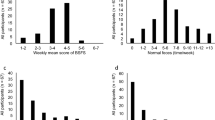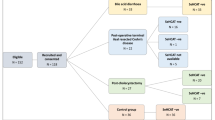Abstract
Epidemiological investigations have shown an association between the incidence of colonic cancer, dietary habits, and bile acid metabolism. We analyzed the fecal bile acid excretion pattern in 23 patients with colonic carcinoma and in 21 controls. We determined the total bile acid concentration, the concentration of individual bile acids as a measure for bacterial degradation, and the degree of sulfation. Separation of nonsulfated and sulfated bile acids was achieved by the lipophilic anion-exchanger DEAP-Sephadex-LH 20, quantification of individual bile acids by gas-liquid chromatography. Corresponding with a significantly lower stool mass per day, colonic cancer patients had a lower daily bile acid excretion. But we found no statistically significant difference between the groups in the fecal concentration of total or individual bile acids or their mode of conjugation. There was a wide variation of total bile acid concentration within each group. Most bile acids were expectedly in the free state, only a low percentage in the glycine- or taurine-conjugated form. The sulfated fraction was small and not different in the two groups. Although our data do not refute the hypothesis of bile acids being implicated in the pathogenesis of colorectal cancer, they do not support it.
Similar content being viewed by others
References
Doll R: The geographical distribution of cancer. Br J Cancer 23:1–8, 1969
Burkitt, DP: Epidemiology of cancer of the colon and rectum. Cancer 28:3–13, 1971
Wynder EL, Shigematsu T: Environmental factors of cancer of the colon and rectum. Cancer 20:1520–1561, 1967
Haenszel W, Berg JW, Segi M, Kurihara M, Locke FB: Large bowel cancer in Hawaiian Japanese. J Natl Cancer Inst 51:1765–1779, 1973
Aries V, Crowther JS, Drasar BS: Bacteria and the aetiology of cancer of the large bowel. Gut 10:334–335, 1969
Wynder EL, Kajitani T, Ishikawa S, Dodo H, Takano A: Environmental factors of cancer of the colon and rectum. Cancer 23:1210–1220, 1969
Hill MJ, Crowther JS, Drasar BS: Bacteria and etiology of cancer of the large bowel. Lancet 1:95–100, 1971
Hill MJ, Aries VC: Fecal steroid composition and its relation to cancer of the large bowel. J Pathol 104:129–139, 1971
Reddy BS, Wynder EL: Large-bowel carcinogenesis: Fecal constituents of populations with diverse incidence rates of colon cancer. J Natl Cancer Inst 50:1437–1442, 1973
Wynder EL, Reddy BS: Metabolic epidemiology of colorectal cancer. Cancer 34:801–806, 1974
Reddy BS, Mastromarino A, Wynder EL: Further leads on metabolic epidemiology of large bowel cancer. Cancer Res 35:3403–3406, 1975
Reddy BS: Diet and excretion of bile acids. Cancer Res 41:3766–3768, 1981
Nigro ND, Bhadrachari N, Chomchai C: A rat model for studying colonic cancer: Effect of cholestyramine on induced tumors. Dis Colon Rectum 16:438–443, 1973
Narisawa T, Magadia NE, Weisburger JH, Wynder EL: Promoting effect of bile acids on colon carcinogenesis after intrarectal instillation ofN-methyl-N-nitro-N-nitrosoguanidine in rats. J Natl Cancer Inst 53:1093–1097, 1974
Reddy BS, Narisawa R, Weisburger JH, Wynder EL: Promoting effect of sodium deoxycholate on colon adenocarcinomas in germ-free rats. J Natl Cancer Inst 56:441–442, 1976
Silverman SJ, Andrews AW: Bile Acids: Comutagenic acitivity in theSalmonella-mammalian-microsome mutagenicity test. J Natl Cancer Inst 59:1557–1559, 1977
Wilpart M, Mainguet P, Maskens A, Roberfroid M: Mutagenicity of 1,2-dimethylhydrazine towardsSalmonella typhimurium, comutagenic effect of secondary bile acids. Carcinogenesis 4:45–48, 1983
Hill MJ, Drasar BS, Williams REO, Meader TW, Cox AG, Simpson JEP, Morson BC: Fecal bile acids and clostridia in patients with cancer of the large bowel. Lancet 1:535–539, 1975
Reddy BS, Wynder EL: Metabolic epidemiology of colon cancer. Fecal bile acids and neutral sterols in colon cancer patients and patients with adenomatous polyps. Cancer 39:2533–2539, 1977
Moskovitz M, White C, Barnett RN, Stevens S, Russell E, Vargo D, Floch MH: Diet, fecal bile acids, and neutral sterols in carcinoma of the colon. Dig Dis Sci 24:746–751, 1979
Murray WR, Blackwood A, Trotter JM, Calman KC, MacKay C: Faecal bile acids andClostridia in the etiology of colorectal cancer. Br J Cancer 41:923–928, 1980
Mudd DG, McKelvey STD, Norwood W, Elmore DT, Roy AD: Fecal bile acid concentrations of patients with carcinoma or increased risk of carcinoma in the large bowel. Gut 21:587–590, 1980
Kaibara N, Sasaki T, Ikeguchi M, Koga S, Ikawa S: Fecal bile acids and neutral sterols in Japanese with large bowel carcinoma. Oncology 40:255–258, 1983
Breuer NF, Rampton DS, Tammar A, Murphy GM, Dowling RH: Effect of colonic perfusion with sulfated and nonsulfated bile acids on mucosal structure and function in the rat. Gastroenterology 84:969–977, 1983
Breuer N, Dommes P, Tandon R, Goebell H: Isolierung und Quantifizierung nicht-sulfatierter und sulfatierter Gallensäuren im Stuhl. J Clin Chem Clin Biochem 22:623–631, 1984
Almé, B, Bremmelgaard A, Sjövall J, Thomassen P: Analysis of metabolic profiles of bile acids in urine using a lipophilic anion exchanger and computerized gas-liquid chromatography-mass spectrometry. J Lipid Res 18:339–362, 1977
van Berge-Henegouwen GP, Allan RN, Hofmann AF, Yu PYS: A facile hydrolysis-solvolysis procedure for conjugated bile acid sulfates. J Lipid Res 18:118–122, 1977
Roseleur OJ, van Gent CM: A simplified method for the determination of steroids in diets and faeces. Clin Chim Acta 82:13–23, 1978
Perogambros A, Legakis NJ: Faecal bile acids in patients with colon cancer. Zentralbl Bakteriol Mikrobiol Hyg (B) 176:346–348, 1982
Hill MJ: Genetic and environmental factors in human colorectal cancer.In Colonic Carcinogenesis. RA Malt, RCN Williamson (eds). Lancaster, MTP Press, 1982, pp. 73–79
Morson BC: The polyp-cancer sequence in the large bowel. Proc R Soc Med 67:451–457, 1974
Hill MJ, Morson BC, Bussey HJR: Etiology of adenoma-carcinoma sequence in large bowel. Lancet 1:245–247, 1978
Van der Werf SDJ, Nagengast FM, van Berge Henegouwen GP, Huijbergts AWM, van Tongeren JHM: Colonic absorption of secondary bile acids in patients with adenomatous polyps and in matched controls. Lancet 1:759–762, 1982
Summerton J: Bile acid receptors in colorectal cancer. Br J Surg 70:549–551, 1983
Reddy BS, Watanabe K, Weisburger JH, Wynder EL: Promoting effect of bile acids in colon carcinogenesis in germ free and conventional F 344 rats. Cancer Res 37:3238–3242, 1977
Wilpart M, Mainguet P, Maskens A, Roberfroid M: Structure-activity relationship amongst biliary acids showing comutagenic activity towards 1,2-dimethylhydrazine. Carcinogenesis 4:1239–1241, 1983
Palmer RH: Bile acid heterogeneity and the gastrointestinal epithelium: From diarrhea to colon cancer. J Lab Clin Med 94:655–660, 1979
Chadwick VS, Gaginella TS, Carlson GL, Debongnie JC, Phillips SF, Hofmann AF: Effect of molecular structure on bile acid-induced alterations in absorptive function, permeability and morphology in the perfused rabbit colon. J Lab Clin Med 94:661–674, 1979
Gordon SJ, Kinsey MD, Magen JS, Joseph RE, Kowlessar OD: Structure of bile acids associated with secretion in the rat cecum. Gastroenterology 77:38–44, 1979
Cohen BI, Raicht RF, Deschner EE, Takahashi M, Sarwal AN, Fazzini E: Effect of cholic acid feeding onN-methyl-N-nitrosourea-induced colon tumors and cell kinetics in rats. J Natl Cancer Inst 64:573–578, 1980
Deschner EE, Cohen BI, Raicht RF: Acute and chronic effect of dietary cholic acid on colonic epithelial cell proliferation. Digestion 21:290–296, 1981
Valhouny GV, Cassidy MM, Lightfoot F, Grau L, Kritchevsky D: Ultrastructural modifications of intestinal and colonic mucosa induced by free or bound bile acids. Cancer Res 41:3764–3765, 1981
Maskens AP, Deschner EE: Tritiated thymidine incorporation into epithelial cells of normal-appearing colorectal mucosa of cancer patients. J Natl Cancer Inst 58:1221–1224, 1977
Gadacz TR, Allan RN, Mack E, Hofmann AF: Impaired lithocholate sulfation in the rhesus monkey: A possible mechanism for chenodeoxycholate toxicity. Gastroenterology 70:1125–1129, 1976
Subbiah MTR, Tyler NE, Buscaglia MD, Marai L: Estimation of bile acid excretion in man: Comparison of isotopic turnover and fecal excretion methods. J Lipid Res 17:78–84, 1976
McJunkin B, Fromm H, Sarva RP, Amin P: Factors in the mechanism of diarrhea in bile acid malabsorption: Fecal pH—a key determinant. Gastroenterology 80:1454–1464, 1981
Podesta MT, Murphy GM, Sladen GE, Dowling RH: Sulfated faecal bile acid excretion—an underestimated factor. Clin Sci Mol Med 54:32 p, 1978
Tanida N, Hikasa Y, Hosomi M, Satomi M, Oohama I, Shimoyama T: Fecal bile acid analysis in healthy Japanese subjects using a lipophilic anion exchanger, capillary column gas chromatography and mass spectrometry. Gastroenterol Jpn 16:363–371, 1981
Setchell KDR, Lawson AM, Tanida N, Sjövall J: General methods for the analysis of metabolic profile of bile acids and related compounds in feces. J Lipid Res 24:1085–1100, 1983
Eastwood MA, Hamilton D: Studies on the adsorption of bile salts to nonabsorbed components of diet. Biochim Biophys Acta 152:165–173, 1968
Kay RM, Truswell AS: Effect of wheat fibre on gastrointestinal function, plasma lipids and steroid excretion in man. BR J Nutr 37: 227–234, 1977
Wargovich MJ, Eng VWS, Newmark HL, Bruce WR: Calcium ameliorates the toxic effect of deoxycholic acid on colonic epithelium. Carcinogenesis 4:1205–1207, 1983
Newmark HL, Wargovich MJ, Bruce WR: Colon cancer and dietary fat, phosphate, and calcium: A hypothesis. J Natl Cancer Inst 72:1323–1325, 1984
Hill MJ: Bile, bacteria and bowel cancer. Gut 24:871–875, 1983
Author information
Authors and Affiliations
Additional information
The study was supported by the Deutsche Forschungsgemeinschaft (SFB 102/D2).
Rights and permissions
About this article
Cite this article
Breuer, N.F., Dommes, P., Jaekel, S. et al. Fecal bile acid excretion pattern in colonic cancer patients. Digest Dis Sci 30, 852–859 (1985). https://doi.org/10.1007/BF01309516
Received:
Revised:
Accepted:
Issue Date:
DOI: https://doi.org/10.1007/BF01309516




